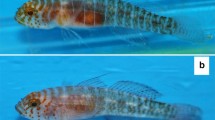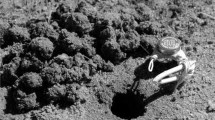Summary
Postcopulatory mate guarding in crustaceans traditionally has been viewed as a behavioral mechanism that prevents predation on the soft post-molt female. This study tests the effects of sexual selection and predation on the postcopulatory guarding durations of male stone crabs, Menippe mercenaria, M. adina, and their hybrid. Male stone crabs were held with a pre-molt female, and either another adult male stone crab, an intermolt female, or a male blue crab, which corresponded to intermale competition, control, and predation treatments, respectively. The mating behavior of the heterosexual pair was recorded with a time lapse video system and the durations of copulation and postcopulatory guarding were measured. Males guarded longer in the intermale competition treatment than either the control or predation treatments. In the competition treatment, agonistic encounters occurred between the males at the den containing the female and several mate takeovers occurred. Females survived the predation treatment in trials in which the guarding durations were the longest, whereas females were eaten by the blue crab in trials with the shortest guarding durations. Sexual selection appears to be important in maintaining postcopulatory mate guarding in stone crabs.
Similar content being viewed by others
References
Austad SN (1984) Evolution of sperm priorty patterns in spiders. In: Sperm competition and the evolution of animal mating systems. Academic Press, Orlando, pp 223–249
Birkhead TR, Clarkson K (1980) Mate selection and precopulatory guarding in Gammarus pulex. Z Tierpsychol 52:365–380
Bliss DE (1960) Autotomy and regeneration. In: Waterman TH (ed) The physiology of crustacea. I. Metabolism and growth. Academic Press, London New York, pp 561–589
Cheung TS (1968) Transmolt retention of sperm in the female stone crab, Menippe mercenaria (Say). Crustaceana (Leiden) 15:118
Cheung TS (1969) The environmental and hormonal control of growth and reproduction in the adult female stone crab, Menippe mercenaria (Say). Biol Bull 136:327–346
Dickinson JL (1986) Prolonged mating in the milkweed leaf beetle Labdomera clivicollis clivicollis (Coleoptera: Chrysomelidae): a test of the “sperm loading” hypothesis. Behav Ecol Sociobiol 18:331–338
Edwards E (1966) Mating behaviour in the European edible crab (Cancer pagurus L.). Crustaceana (Leiden) 10:23–30
Elner RW, Gass CA, Campbell A (1985) Mating behavior of the Jonah crab, Cancer borealis Stimpson (Decapoda, Brachyura). Crustaceana (Leiden) 48:34–39
Ghiselin MT (1974) Economy of nature and the evolution of sex. University of California Press, Berkely, p 345
Gwynne DT (1984) Male mating effort confidence of paternity, and insect sperm competition. In: Sperm competition and the evolution of animal mating systems. Academic Press, Orlando, pp 117–149
Hartnoll RG (1969) Mating in the brachyura. Crustaceana (Leiden) 16:161–181
Hazlett BA (1975) Ethological analyses of reproductive behavior in marine crustacea. Pubbl Staz Zool Napoli 39:677–695
Manning JT (1980) Sex ratio and optimal male time investment strategies in Asellus aquaticus (L.) and A. meridianus Racovitza. Behaviour 74:264–273
Nelson K, Hedgecock D (1977) Electrophoretic evidence of multiple paternity in the lobster Homarus americanus (Milne-Edwards). Am Nat 111:361–365
Noe CD (1967) Contribution to the life history of the stone crab Menippe mercenaria Say with emphasis on the reproductive cycle. University of Miami, Coral Gables, p 56
Parker GA (1970a) The reproductive behavior and the nature of sexual selection in Scatophaga stercoraria L. (Diptera: Scatophagidae) VII. The origin and evolution of the passive phase. Evolution 24:791–805
Parker GA (1970b) Sperm competition and its evolutionary effect on copula duration in the fly Scatophaga stercoraria. J Insect Physiol 16:1301–1328
Ridley M (1983) The explanation of organic diversity: the comparative method and adaptations for mating. Clarendon Press, Oxford, p 272
Ridley M, Thompson DJ (1979) Size and mating in Asellus aquaticus (Crustacea: Isopoda). Z Tierpsychol 51:380–397
Salmon M (1983) Courtship, mating systems, and sexual selection in decapods. In: Rebach S, Dunham D (eds) Studies in adaptation: the behavior of higher Crustacea. Wiley, New York, pp 143–169
Savage T (1971) Mating of the stone crab, Menippe mercenaria (Say) (Decapoda, Brachyura). Crustaceana (Leiden) 20:315–316
Sillen-Tullberg B (1981) Prolonged copulation: a male ‘postcopulatory’ strategy in a promiscuous species, Lygaeus equestris (Heteroptera: Lygaeidae). Behav Ecol Sociobiol 9:283–289
Sinclair ME (1977) Agonistic behavior of the stone crab, Menippe mercenaria (Say). Anim Behav 25:193–207
Smith RL (1980) Repeated copulation and sperm precedence: Paternity assurance for a male brooding water bug. Science 205:1029–1031
Sullivan JR (1979) The stone crab, Menippe mercenaria, in the southwest Florida fishery. Fla Mar Res Pub 36:37
Thornhill R, Alcock J (1983) The evolution of insect mating systems. Harvard University Press, Boston, p 547
Van Engel WA (1958) The blue crab and its fishery in the Chesapeake Bay. 1. Reproduction, early development, growth, and migration. Commer Fish Rev 20:6–17
Waage JK (1979) Adaptive significance of postcopulatory guarding of mates and nonmates by male (Calpteryx maculata (Odonata). Behav Ecol Sociobiol 6:147–154
Wilber DH (1986) The distribution and daily movement of stone crabs (Menippe mercenaria) in an intertidal oyster habitat on the northwest coast of Florida. Mar Behav Physiol 12:279–291
Wilber DH (1987) The role of mate guarding in stone crabs. Dissertation, Florida State University, Tallahassee, p 136
wilber DH (1988) Observations on the mating patterns and distribution of adult stone crabs, (genus Menippe) on the northern Gulf of Mexico. In: Proceedings of a symposium on the stone crab (genus Menippe) biology and fisheries. Florida Dept. of Natural Resources St. Petersburg
Wilber DH (in press) Reproductive biology and distribution of stone crabs (Xanthidae, Menippe) in the hybrid zone on the northeastern Gulf of Mexico. Mar Ecol Prog Ser
Wilber DH, Herrnkind WF (1986) The fall emigration of stone crabs Menippe mercenaria (Say) from an intertidal oyster habitat and temperature's effect on locomotory activity. J Exp Mar Biol Ecol 102:209–221
Williams AB, Felder DL (1986) Analysis of stone crabs: Menippe mercenaria (Say), restricted, and a previously unrecognized species described (Decapoda: Xanthidae). Proc Biol Soc Wash 99:517–543
Wittenberger JF (1981) Animal social behavior. Duxbury Press, Belmont
Woodhead AP (1985) Sperm mixing in the cockroach Diplotera punctata. Evolution 39:159–164
Author information
Authors and Affiliations
Rights and permissions
About this article
Cite this article
Wilber, D.H. The influence of sexual selection and predation on the mating and postcopulatory guarding behavior of stone crabs (Xanthidae, Menippe). Behav Ecol Sociobiol 24, 445–451 (1989). https://doi.org/10.1007/BF00293274
Received:
Accepted:
Issue Date:
DOI: https://doi.org/10.1007/BF00293274




